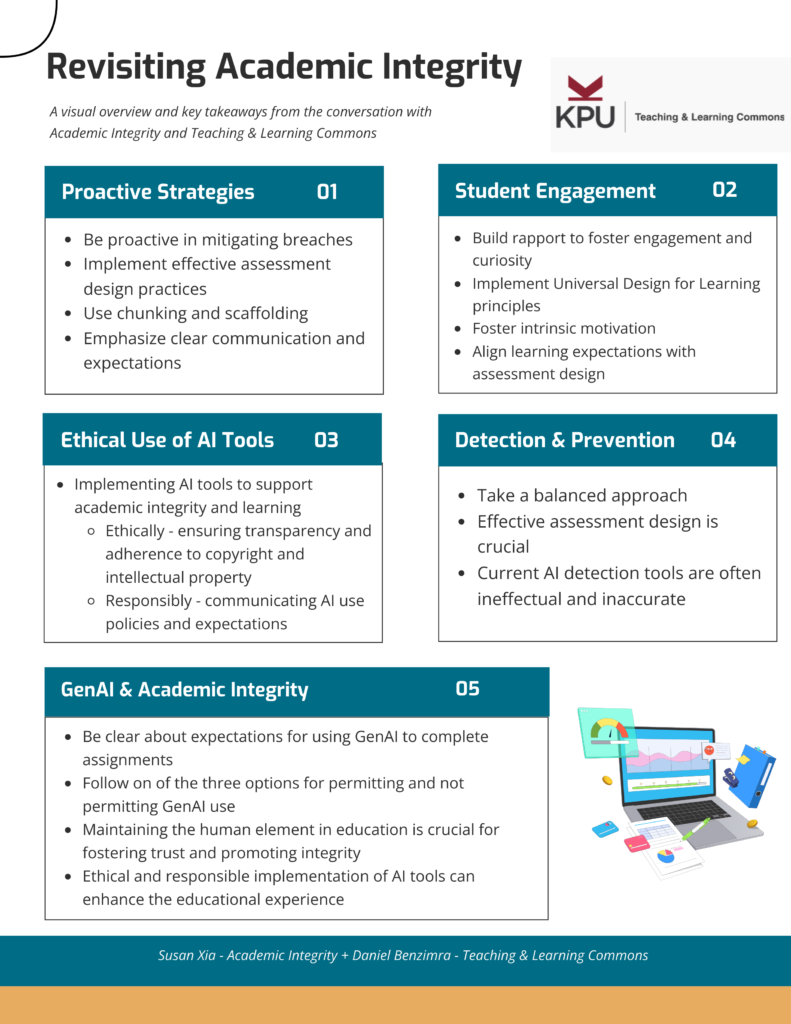Revisiting Academic Integrity in the World of Generative AI
A conversation with the Academic Integrity Unit and Teaching & Learning Commons
The TL Commons and the Academic Integrity Unit partner to provide support around academic integrity. The role of T&L Commons is to support instructors with their pedagogical needs (such as course and assessment design and instructional practice) and the role of the Academic Integrity Unit is to support instructors proactively in upholding academic integrity and honesty, as well as assist during possible academic integrity breaches. We both interact regularly with instructors who are concerned about academic honesty and how to promote it in their courses in order to support meaningful assessment of learning. It is common for instructors to worry about student academic success, policing students, and accurately evaluating student work.
Susan Xia (Academic Integrity Unit) and Daniel Benzimra (Teaching & Learning Commons) recently met to discuss common themes from their respective departments in supporting instructors’ assessment design and evaluation and the role this plays in fostering a culture of academic integrity. This blog is a collation of this conversation around the following identified themes, and the resources we offer to support faculty engagement with this topic.
Theme 1: Proactive Strategies – Engagement and Rapport
Proactive strategies for addressing academic misconduct in higher education emphasize the importance of building strong relationships with students. By fostering curiosity through real-life stories and experiences, educators can create a learning environment where students feel engaged and motivated. Designing assessments that provide students with autonomy and agency allows them to explore topics of interest, making the learning process more meaningful and reducing the temptation to resort to dishonest tools.
Recognizing that disconnection from learning can lead to academic dishonesty, it is crucial to provide clear expectations and support. When students understand their assignments and feel capable of managing their workload, they are less likely to engage in dishonest behavior. Implementing chunking and scaffolding techniques can break down large tasks into manageable steps, helping students to approach their work methodically and reducing feelings of overwhelm. This approach not only aids in completing assignments but also teaches valuable skills for future projects.
Embracing Universal Design for Learning (UDL) principles by offering various assessment methods, such as presentations, infographics, or other creative formats, caters to different learning styles and preferences. This flexibility allows students to demonstrate their understanding in ways that best suit their strengths, fostering a deeper connection to the material. Smaller class sizes, like what we have at KPU, can further enhance this approach by facilitating meaningful conversations and trust-building between students and instructors. These interactions help students feel a sense of belonging and accountability, which can deter academic dishonesty.
Ensuring clarity in expectations, especially regarding the use of generative AI, is essential. As generative AI tools become more prevalent, students may be uncertain about their appropriate use. Providing consistent guidelines across the course and assignments helps reduce confusion and promotes academic integrity. Clear communication about what is expected and permissible can prevent misunderstandings and encourage students to adhere to ethical standards.
In summary, proactive strategies for building rapport and facilitating engagement in higher education involve creating a supportive and engaging learning environment. By building strong relationships, fostering curiosity, providing clear expectations, and offering diverse assessment methods, educators can reduce the likelihood of academic integrity breaches. These approaches not only enhance the learning experience but also equip students with the skills and integrity needed for their future career and academics.
Theme 2: Assessment Design Strategies
Effective assessment design is crucial for accurately evaluating student learning. Including clear policies in the syllabus and discussing them in class ensures students understand the expectations for each assessment. This proactive communication helps prevent misunderstandings and reinforces the importance of academic integrity. Faculty support, such as the Faculty Resource Shelf, provides valuable resources on academic integrity, assessment design, and evaluation.
One suggestion is to emphasize the importance of students’ voices and ideas in written assignments. The focus would be on demonstrating the learning objectives rather than worrying on the minutiae of writing mechanics. This approach encourages students to engage deeply with the material and express their unique perspectives.
In summary, effective assessment design involves clear communication of policies, supportive discussions about assignment expectations, and a focus on students’ unique contributions. By prioritizing these strategies, educators can create assessments that accurately evaluate student learning and uphold academic integrity.
Theme 3: Generative AI (GenAI) & Academic Integrity
Addressing academic integrity in the context of generative AI involves recognizing and responding to concerns about detecting academic misconduct. Instructors have a choice of three options for GenAI use in their courses, but overall, the consideration is about ensuring that assessments reflect true student learning and demonstration of that learning therein.
Instructors can design assessments that prioritize human-generated content while accounting for the use of GenAI when permitted. Effective assessment design plays a crucial role in reducing the likelihood of academic dishonesty. While some advocate for harsher punishments, it is essential to focus on the initial setup and design of assessments. Well-designed assessments can significantly decrease the chances of students resorting to dishonest practices. It is important to acknowledge that no tool can detect GenAI use with complete accuracy and without false positives. Therefore, the emphasis should be on creating assessments that inherently discourage dishonesty.
Instructors often seek a “silver bullet” solution for detecting GenAI use, especially in uncertain or complex situations. However, there is no single solution that can address all concerns. Instead, a proactive stance involves designing assessments that prioritize academic integrity and human-generated content. This approach includes clear communication about expectations and permissible uses of GenAI. Building rapport between instructors and students is also important as it fosters a shared understanding of academic integrity. Both commit to producing and evaluating work that is genuinely their own.
Ongoing discussions about detecting GenAI highlight the challenges compared to traditional plagiarism detection. Unlike direct copy-paste plagiarism, which can be easily verified, detecting GenAI use requires identifying red flags such as false citations, vagueness, or irrelevance to the assignment. These indicators necessitate conversations with students to clarify their work and intentions.
If students express an interest in using GenAI for assignments, it is essential to discuss their plans and reasons. This dialogue can reveal uncertainty of instructions, or if students feel unable to meet expectations, allowing instructors to provide the necessary support. Such discussions ensure that assessments genuinely measure learning and retention, rather than just completion (learning for proficiency rather than for final product). Effective rubric design is a great evidence-based approach to assessment and evaluation of learning.
In summary, addressing academic integrity in the era of GenAI involves a multifaceted approach. Open communication, effective assessment design, and proactive measures are key to ensuring that assessments accurately reflect student learning and uphold academic standards. By focusing on these strategies, educators can better navigate the complexities of GenAI and maintain the integrity of the academic process.
Theme 4: Supports & Resources for Academic Honesty
In thinking about supports and resources, there is an idea of shared responsibility, where everyone that has a stake in it can contribute to fostering that culture of integrity. It also puts front and center the relationship piece. There are supports and resources available from both instructor and student perspectives.
For resources, the Academic Integrity Unit has a compilation on our Faculty Resource Shelf, including our website, different guides on communicating with students, suggestions on informal or additional resolutions aside from the traditional grade penalties, and how to report a possible academic integrity breach formally. We also have resources that highlight ways that we help students develop skills to prevent breaches in the future. This includes supporting them in the process of learning from their mistakes and sharing resources such as The Learning Centers or the option to meet with the library to learn about citations. Student students have shared that it’s helpful when an instructor brings someone into their classroom, such as a Librarian and as part of their class they get an overview of how to do research and how to go through and navigate to the different online resources.
The Academic Integrity Unit is also working on providing more resources around restorative justice approaches. We have a Moodle course that’s developed by Dr. Alana Abramson that faculty can go through. It includes self-paced videos, examples, as well as sample language to get the conversation started.
And of course, faculty are always welcome to reach out to the Academic Integrity Unit, and we can talk through their situation and provide suggestions or ideas to consider.
From the Teaching & Learning Commons side, we offer a lot more support from the design side for assessments. Here is a resource with tips for assignment design to promote academic integrity. In particular in this area, we offer workshops on rubric design, on learning outcomes, and on constructive alignments. We also have the Generative AI WordPress site which is host to a variety of resources that are practical, discipline-specific and in general, and focus on both assessments and teaching and learning activities.
We also have the GenAI rubric support; instructors are able to submit their assignments as well as their current rubric, and they can receive support and feedback about how they can design their rubric to meet their expectations for student use of GenAI. We also have the GenAI CoP meeting once a month virtually and then once a semester in-person. And we’re doing a lot of work in there about instructors exploring different tools available to them and different ways that it can be used. The exposure, practice, and really understanding what GenAI can and can’t do will also better help and support instructors for understanding GenAI and academic integrity.
Conclusion
In our current world of GenAI, the emphasis on the human pieces is important. The conversations that we’ve had highlight that the human piece is irreplaceable. Taking away the human changes the entire learning experience, and students have shared that they want that connection with other humans in the room.
It is also to know that if someone says a human is doing this, you want to make sure – that’s that responsibility and ethical part, that yes, it is a human and it’s not a captcha test, “click here if you are a human.”
In conclusion, Susan and Daniel agree that AI tools have significant potential to support both academic integrity and learning. However, it is essential to implement these tools ethically and responsibly, ensuring that they enhance rather than undermine the educational experience.
Reach out to Susan and the Academic Integrity Unit at: academic.integrity@kpu.ca
Reach out to Teaching & Learning Commons at: tlcommons@kpu.ca
Reach out to GenAI Rubrics Feedback at: genairubrics@kpu.ca
Review Academic Integrity Support resources from the Academic Integrity Unit and the Teaching and Learning Commons.




